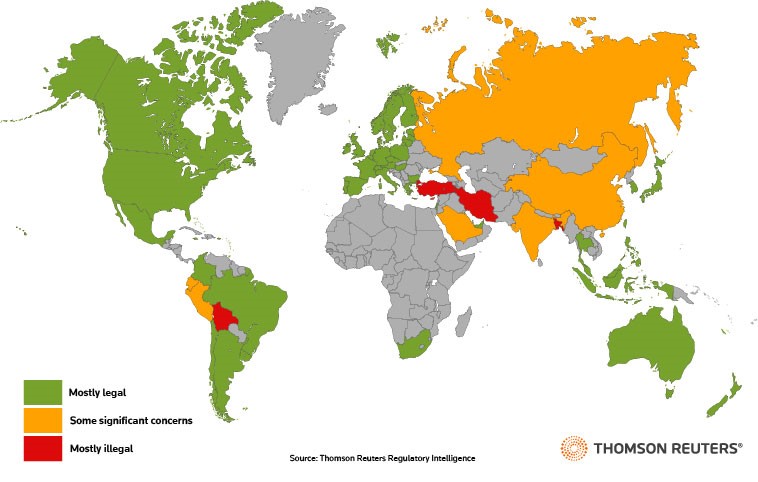Thomson Reuters Regulatory Intelligence has published a special report and compendium taking a look at the potential benefits and challenges of cryptos together with an overview of the regulatory landscape for cryptocurrencies such as bitcoin. The compendium was first published on the Answers On blog and provides valuable information about the legality, tax treatment, evolving regulatory framework or viewpoint on a country-by-country basis for approximately 60 jurisdictions.

Digital transformation and the deployment of crypto-assets have great potential to make payments and transfers more efficient. However, the speed and reach of transactions, together with the potential for anonymous activity and for transactions without financial intermediaries, also make crypto-assets vulnerable to misuse and raise the risk of money laundering.
Financial services firms, regulators and policymakers are all having to come to terms with the rise of a new class of product. The special report examines some of these developments as well as the risks and benefits of this next iteration of digital transformation. It also considers the problems arising from the lack of an internationally consistent definition of the term “crypto”.
It looks at the implications for financial services firms and their customers of the potential for central bank digital currencies and the possible emerging arms race as central banks examine the ramifications of, and seek to deploy, digital currencies. A closer look is taken at the approach in China, the UK, and the U.S. Cyber risk is a concern for all cryptos, and the report considers how firms, regulators and exchanges can enhance their cyber resilience.
“Of the three areas I’ve covered, cyber presents arguably the most difficult prudential threat: unlike GCRA [governance, culture, remuneration and accountability] or climate risk, it’s driven by malicious and adaptive adversaries who are intent on causing damage. Cyclones and bushfires can be devastating, but they’re not doing it on purpose.”
Wayne Byres, chair of the Australian Prudential Regulation Authority, in a speech to the Committee for the Economic Development of Australia, April 2021
Policymakers, regulators and firms all need to play their part in ensuring that cryptos are as “safe” as possible not only in terms of investment risk but with regards to regulatory certainty and cyber resilience.
Supranational policymakers must continue to work toward consistent definitions of what is, and what is not, inside the regulatory perimeter. Cryptos may be treated as a currency, an investment or a security under current regulatory regimes, or they may not be covered at all. Cryptos, bitcoin in particular, may have gone mainstream but if they are to deliver their potential there is a need for clarity about how they are supervised.
A good first step would be alignment on definitions. Even if jurisdictions end up banning some or all cryptos (particularly for retail customers), it would be on the basis that international financial services had a common understanding of what was legal, and where.
The regulatory overlay for crypto-assets is rapidly evolving as several countries are at the forefront of adoption and are establishing themselves as crypto-friendly. Singapore, Bermuda, the EU, and the UK are establishing themselves as allies to varying degrees. Parts of Africa and India have meanwhile taken steps to restrict or prohibit citizens from owning or using cryptos.
Harmonization or coordination of rules will be essential but may not happen for some years. In the interim, the regulatory landscape for digital assets will evolve, probably more slowly than some desire and likely at a much slower than the forms of technology themselves.
It is in everyone’s interest that cryptos are subject to a regulatory regime with a clear perimeter, coherent definitions and an agreed, well-informed stance on risk and risk management.


